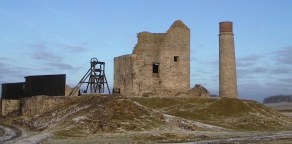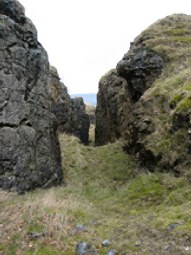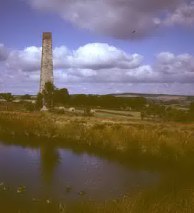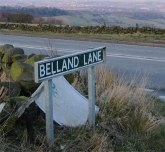
Peak District Lead Mining
LEAD: Pure lead is a soft, heavy metal, easily worked but with a low melting point. In the past it was extensively used for plumbing, roofing and creating paint pigments and is used in electrical batteries and metal alloys to this day. In common with many other metals, it's value has swung up and down with the cycle of world events: high in war, low in recession.  A combination of dwindling reserves and competition from reserves found in Australia at the end of the 19th century saw the end of Peak District commercial mining early in the 20th century. (The last rich deposit, the Mill Close mine near Darley Dale, was worked until 1939).
A combination of dwindling reserves and competition from reserves found in Australia at the end of the 19th century saw the end of Peak District commercial mining early in the 20th century. (The last rich deposit, the Mill Close mine near Darley Dale, was worked until 1939).
 A combination of dwindling reserves and competition from reserves found in Australia at the end of the 19th century saw the end of Peak District commercial mining early in the 20th century. (The last rich deposit, the Mill Close mine near Darley Dale, was worked until 1939).
A combination of dwindling reserves and competition from reserves found in Australia at the end of the 19th century saw the end of Peak District commercial mining early in the 20th century. (The last rich deposit, the Mill Close mine near Darley Dale, was worked until 1939).LEAD ORE: Lead is never found in a pure state; in the Peak District it is usually chemically bonded to sulphur. This ore, lead sulphide, is termed 'galena'. Ore veins generally contained about 10% galena, but this means, however, that a minimum of 9 tons of waste had to be removed for every ton of lead ore. Veins with as little as 2% galena were worked when prices were high.
MINING: Galena was found in most Peak District limestone areas, but the main mines were in two broad bands: one between Wirksworth and Matlock, and other between Eyam and Castleton and in areas centered on Youlgreave, Monyash, Carsington and Hartington. The landscape produced by ancient mining: Hollows and hillocks, can be seen at locations such as Carsington Pasture. Long Cliff, the hillside between Castleton and the Speedwell Cavern displays good examples of lines of spoil heaps and collapsed vertical shafts following mineral veins.  Mine shafts were theoretically sealed when abandoned, and most have collapsed ("run-in") so that the top at least is blocked. However there are scores still open, some completely unfenced and offering a vertical fall for a hundred feet or more, so care is always needed around lead workings. Horizontal shafts can be seen in locations such as Lathkill Dale, where mining has gone on for centuries, but these should never be entered without expert help. Lathkill Dale also contains the remains of the Mandale Mine, a "state of the art" venture from the mid 19th century. At about a kilometre upstream from Over Haddon a horizontal drain, a " sough", still discharges water into the river (Grid Ref: 197662). Soughs were near horizontal, and run from the lowest point available (usually near a river) to some point underneath lead workings which had reached down to the level of the water table. The sough then drained the area, so dropping the water table and allowing mining to continue. Nearby is a massive wall. This was a "bob wall", on which balanced a large beam, one end attached to a steam engine, the other to rods that worked pumps about 90 feet underground. Further upstream are pillars that supported an aqueduct that brought water to a water wheel which also powered pumps. Lathkill Dale was extensively re-modelled in the interests of mining : the bed of the river was straightened and lined with clay to prevent it's water from penetrating the workings, and the aqueduct was fed from a channel (a "goit") which runs parallel to the river further upstream.
Mine shafts were theoretically sealed when abandoned, and most have collapsed ("run-in") so that the top at least is blocked. However there are scores still open, some completely unfenced and offering a vertical fall for a hundred feet or more, so care is always needed around lead workings. Horizontal shafts can be seen in locations such as Lathkill Dale, where mining has gone on for centuries, but these should never be entered without expert help. Lathkill Dale also contains the remains of the Mandale Mine, a "state of the art" venture from the mid 19th century. At about a kilometre upstream from Over Haddon a horizontal drain, a " sough", still discharges water into the river (Grid Ref: 197662). Soughs were near horizontal, and run from the lowest point available (usually near a river) to some point underneath lead workings which had reached down to the level of the water table. The sough then drained the area, so dropping the water table and allowing mining to continue. Nearby is a massive wall. This was a "bob wall", on which balanced a large beam, one end attached to a steam engine, the other to rods that worked pumps about 90 feet underground. Further upstream are pillars that supported an aqueduct that brought water to a water wheel which also powered pumps. Lathkill Dale was extensively re-modelled in the interests of mining : the bed of the river was straightened and lined with clay to prevent it's water from penetrating the workings, and the aqueduct was fed from a channel (a "goit") which runs parallel to the river further upstream.
 Mine shafts were theoretically sealed when abandoned, and most have collapsed ("run-in") so that the top at least is blocked. However there are scores still open, some completely unfenced and offering a vertical fall for a hundred feet or more, so care is always needed around lead workings. Horizontal shafts can be seen in locations such as Lathkill Dale, where mining has gone on for centuries, but these should never be entered without expert help. Lathkill Dale also contains the remains of the Mandale Mine, a "state of the art" venture from the mid 19th century. At about a kilometre upstream from Over Haddon a horizontal drain, a " sough", still discharges water into the river (Grid Ref: 197662). Soughs were near horizontal, and run from the lowest point available (usually near a river) to some point underneath lead workings which had reached down to the level of the water table. The sough then drained the area, so dropping the water table and allowing mining to continue. Nearby is a massive wall. This was a "bob wall", on which balanced a large beam, one end attached to a steam engine, the other to rods that worked pumps about 90 feet underground. Further upstream are pillars that supported an aqueduct that brought water to a water wheel which also powered pumps. Lathkill Dale was extensively re-modelled in the interests of mining : the bed of the river was straightened and lined with clay to prevent it's water from penetrating the workings, and the aqueduct was fed from a channel (a "goit") which runs parallel to the river further upstream.
Mine shafts were theoretically sealed when abandoned, and most have collapsed ("run-in") so that the top at least is blocked. However there are scores still open, some completely unfenced and offering a vertical fall for a hundred feet or more, so care is always needed around lead workings. Horizontal shafts can be seen in locations such as Lathkill Dale, where mining has gone on for centuries, but these should never be entered without expert help. Lathkill Dale also contains the remains of the Mandale Mine, a "state of the art" venture from the mid 19th century. At about a kilometre upstream from Over Haddon a horizontal drain, a " sough", still discharges water into the river (Grid Ref: 197662). Soughs were near horizontal, and run from the lowest point available (usually near a river) to some point underneath lead workings which had reached down to the level of the water table. The sough then drained the area, so dropping the water table and allowing mining to continue. Nearby is a massive wall. This was a "bob wall", on which balanced a large beam, one end attached to a steam engine, the other to rods that worked pumps about 90 feet underground. Further upstream are pillars that supported an aqueduct that brought water to a water wheel which also powered pumps. Lathkill Dale was extensively re-modelled in the interests of mining : the bed of the river was straightened and lined with clay to prevent it's water from penetrating the workings, and the aqueduct was fed from a channel (a "goit") which runs parallel to the river further upstream.CRUSHING & SORTING ORE: Galena from the mine would almost always be part of a chunk of rock. The efficiency of the smelting process was in proportion to how effectively the waste limestone and other ("gangue") minerals could be separated out. The earliest means of doing this was by manually hammering each piece of ore. Later, a large grindstone was fixed on a long spindle and used to crush the ore. The remains of a crushing circle can be found below the Odin mine; (grid Ref: 136834). Running water was also used to separate minerals of different densities after crushing. Some of the channels used in the "buddling" process can be located on the hillside south of Winster.
SMELTING: Smelting galena, to extract the pure lead has as long a history as mining. The earliest technology was a sloping stone hearth on which layers of wood and ore were placed; heating at the right temperature broke the chemical bonds in galena to produce molten lead and sulphur. They were- sited on a west facing slope to catch the prevailing wind. These are now mainly preserved only as "Bole Hill" place names, e.g. above Upper Padley.After about 1550, a more efficient system : enclosed ore hearths, where the temperature was controlled by bellows. The remains of an ore hearth, probably dating from the 1640's, can be found in Froggatt Wood.
The oldest industrial chimney in Britain, dating from the mid 18th century, stands at Stone Edge (Grid Ref: 340672) on the site of an industrial smelting site. Here "cupola" furnaces were built which kept fuel and ore separate. The bulk of the lead was extracted from the ore in the furnace. The chimney ensued a strong draft through the system, which typically had long horizontal flues. In the flues, lead that had vapourised in the furnace condensed, and an especially pure form of lead could be collected from the sides of the flue. Another of cupola furnace can be seen at the Magpie Mine near Sheldon; (Grid Ref: 173681) where the buildings from a late 19th century mine and smelting works are preserved. The fumes that escaped contained vapourised lead and were recognised as poisonous, especially to animals grazing in areas where lead was deposited by smoke. The poisoning was called "bellanding" and a Belland Lane runs past the Stone Edge smelter .
century, stands at Stone Edge (Grid Ref: 340672) on the site of an industrial smelting site. Here "cupola" furnaces were built which kept fuel and ore separate. The bulk of the lead was extracted from the ore in the furnace. The chimney ensued a strong draft through the system, which typically had long horizontal flues. In the flues, lead that had vapourised in the furnace condensed, and an especially pure form of lead could be collected from the sides of the flue. Another of cupola furnace can be seen at the Magpie Mine near Sheldon; (Grid Ref: 173681) where the buildings from a late 19th century mine and smelting works are preserved. The fumes that escaped contained vapourised lead and were recognised as poisonous, especially to animals grazing in areas where lead was deposited by smoke. The poisoning was called "bellanding" and a Belland Lane runs past the Stone Edge smelter .
 century, stands at Stone Edge (Grid Ref: 340672) on the site of an industrial smelting site. Here "cupola" furnaces were built which kept fuel and ore separate. The bulk of the lead was extracted from the ore in the furnace. The chimney ensued a strong draft through the system, which typically had long horizontal flues. In the flues, lead that had vapourised in the furnace condensed, and an especially pure form of lead could be collected from the sides of the flue. Another of cupola furnace can be seen at the Magpie Mine near Sheldon; (Grid Ref: 173681) where the buildings from a late 19th century mine and smelting works are preserved. The fumes that escaped contained vapourised lead and were recognised as poisonous, especially to animals grazing in areas where lead was deposited by smoke. The poisoning was called "bellanding" and a Belland Lane runs past the Stone Edge smelter .
century, stands at Stone Edge (Grid Ref: 340672) on the site of an industrial smelting site. Here "cupola" furnaces were built which kept fuel and ore separate. The bulk of the lead was extracted from the ore in the furnace. The chimney ensued a strong draft through the system, which typically had long horizontal flues. In the flues, lead that had vapourised in the furnace condensed, and an especially pure form of lead could be collected from the sides of the flue. Another of cupola furnace can be seen at the Magpie Mine near Sheldon; (Grid Ref: 173681) where the buildings from a late 19th century mine and smelting works are preserved. The fumes that escaped contained vapourised lead and were recognised as poisonous, especially to animals grazing in areas where lead was deposited by smoke. The poisoning was called "bellanding" and a Belland Lane runs past the Stone Edge smelter .
The description above only touches on the mass on information available on lead mining, to go further, look at:
Find Out More - Books on the Peak District: List of sources of information on the Peak District
Copyright @ 2003 Stephen N.Wood. All rights reserved.
This is a Web Counter
This page has been accessed